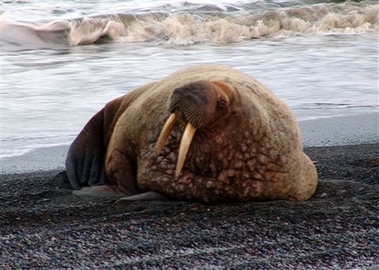
|
|
A walrus
|
Thousands of walrus have appeared on Alaska's northwest coast in what conservationists are calling a dramatic consequence of global warming melting the Arctic sea ice.
Alaska's walrus, especially breeding females, in summer and fall are usually found on the Arctic ice pack. But the lowest summer ice cap on record put sea ice far north of the outer continental shelf, the shallow, life-rich shelf of ocean bottom in the Bering and Chukchi seas.
Walrus feed on clams, snails and other bottom dwellers. Given the choice between an ice platform over water beyond their 630-foot diving range or gathering spots on shore, thousands of walrus picked Alaska's rocky beaches.
"It looks to me like animals are shifting their distribution to find prey," said Tim Ragen, executive director of the federal Marine Mammal Commission. "The big question is whether they will be able to find sufficient prey in areas where they are looking."
According to the National Snow and Ice Data Center at the University of Colorado at Boulder, September sea ice was 39 percent below the long-term average from 1979 to 2000. Sea ice cover is in a downward spiral and may have passed the point of no return, with a possible ice-free Arctic Ocean by summer 2030, senior scientist Mark Serreze said.
Starting in July, several thousand walrus abandoned the ice pack for gathering spots known as haulouts between Barrow and Cape Lisburne, a 300-mile stretch of Alaska coastline.
The immediate concern of new, massive walrus groups for the U.S. Fish and Wildlife Service is danger to the animals from stampedes. Panic caused by a low-flying airplane, a boat or an approaching polar bear can send a herd rushing to the sea. Young animals can be crushed by adults weighing 2,000 pounds or more.
Longer term, biologists fear walrus will suffer nutritional stress if they are concentrated on shoreline rather than spread over thousands of miles of sea ice.
Walrus need either ice or land to rest. Unlike seals, they cannot swim indefinitely and must pause after foraging.
點擊查看更多雙語新聞
(Agencies)
|
近日���,幾千頭海象出現(xiàn)在美國阿拉斯加西北海岸�����。環(huán)境保護主義者認為�����,這是全球變暖導致北極海冰融化而造成的一個嚴重后果�。
阿拉斯加地區(qū)的海象——尤其是正處于繁殖期的雌海象��,在夏秋季節(jié)通?;钴S在北極的大片浮冰上。但今年夏天北極冰帽面積縮小至歷史最低記錄�,使海冰推移至白令海和楚科奇海一帶底棲生物豐富的淺大陸架外圍的遠北地區(qū)。
海象以蛤蜊�����、蝸牛和其他海底生物為食���。由于冰面下海水深度超過了海象的下潛深度630英尺���,數(shù)千只海象不得不遷移至阿拉斯加的巖石海灘上�。
美國聯(lián)邦海洋哺乳動物委員會執(zhí)行理事蒂姆?里甘說���,“在我看來���,海象們遷移是為了覓食。最重要的問題在于它們能否在新的遷移地覓得充足的食物���?�!?/font>
據(jù)美國科羅拉多大學博爾德分校國家冰雪數(shù)據(jù)研究中心的統(tǒng)計資料顯示����,今年9月的北極海冰面積比1979年至2000年的平均值低39%���。資深科學家馬克?塞雷利茲說�����,北極海冰面積呈螺旋式下降而且可能已經(jīng)超過極限點��。到2030年夏季�,北冰洋的海冰可能將全部融化。
從今年7月開始�,數(shù)千頭海象離開它們原先棲息的浮冰帶,遷移至位于巴羅和利斯本角之間綿延300英里的阿拉斯加海岸線的延伸地帶聚居�。
美國魚類和野生動物管理局擔心集體大遷移的海象會發(fā)生踩踏的危險。低空飛過的飛機���、巡游的輪船或在附近出沒的北極熊都會使海象受到驚嚇而沖進海里���,幼象可能會被重達2000多磅的成年象壓傷甚至壓死���。
生物學家指出�,從長遠來看�,如果海象聚居在海岸上,而非分散地生活在海冰上�����,它們將面臨覓食壓力��。
海象的主要休息地為冰面或陸地�����。與海豹不同,海象不能隨時游泳�,它們在捕食后必須稍作休息。
(英語點津姍姍編輯)
|